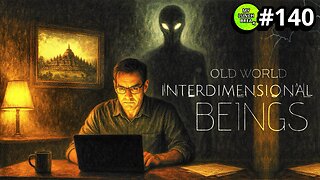Premium Only Content

Reclaiming Emotional Sovereignty: The Transformative Power of Responsibility
Negative emotions are an inevitable part of life, or so we’ve been led to believe. Conventional wisdom suggests that external circumstances—difficult situations, harsh words, or challenging relationships—dictate how we feel. Yet, a profound truth lies just beneath the surface: you are always free to choose the quality of your emotional life.
This article explores the revolutionary concept of emotional responsibility, providing actionable insights into how you can break free from the cycle of blame, transform negative emotions, and regain mastery over your inner world.
I. The Origin of Negative Emotions: Breaking the Blame Habit
1. The Misconception of Emotional Triggers
Most people believe that emotions are reactions to external stimuli. Common phrases like “They made me angry” or “That situation upset me” reinforce the notion that emotions arise from outside forces. However, this is a psychological illusion:
• Reality Check: Emotions are not caused by the external situation itself but by your interpretation and internal response to it.
2. Blame as the Root of Negativity
Blame is the cornerstone of negative emotions. When you attribute your emotional state to another person or situation:
• You Surrender Control: Blame shifts responsibility away from yourself, leaving you powerless to change how you feel.
• You Entrench Negativity: By focusing on blame, you feed a cycle of anger, resentment, and frustration, allowing negativity to take root and grow.
3. Blame Patterns Become Emotional Habits
Repeated blaming creates neural pathways in the brain that reinforce these negative patterns:
• The Feedback Loop: Blaming becomes an automatic response, perpetuating negative emotions and disempowering you from taking ownership of your emotional state.
II. The Key to Emotional Freedom: Radical Responsibility
1. Responsibility Is Not Guilt
Taking responsibility for your emotions does not mean blaming yourself or feeling guilty. Instead, it means:
• Acknowledging Your Power: Recognizing that you have the ability to choose how you respond to any situation.
• Reclaiming Control: Understanding that you—not the external world—dictate your emotional experience.
2. The Power of the Affirmation: “I Am Responsible”
The phrase “I am responsible” is more than an affirmation—it’s a declaration of sovereignty over your inner life. By saying it, you:
• Interrupt Negative Thought Patterns: You immediately disrupt the blame loop that fuels negative emotions.
• Reframe the Situation: Responsibility shifts your focus from what others did to how you can respond constructively.
• Empower Your Mind: It places you firmly in the driver’s seat, allowing you to direct your emotions rather than being controlled by them.
3. The Neuroscience of Responsibility
The brain cannot hold two opposing thoughts simultaneously. By choosing to focus on the empowering affirmation “I am responsible,” you:
• Override Negative Emotions: Positive affirmations suppress neural activity in areas associated with stress and anger.
• Create New Neural Pathways: Repeatedly affirming responsibility strengthens pathways associated with self-control and emotional resilience.
III. The Step-by-Step Process to Emotional Mastery
1. Awareness: Recognize the Emotion
The first step to emotional mastery is awareness:
• Pause and Observe: When a negative emotion arises, take a moment to identify it. Is it anger, frustration, or sadness?
• Separate Emotion from Trigger: Recognize that the emotion is not caused by the situation itself but by your internal response.
2. Break the Blame Cycle
Once you’ve identified the emotion, consciously interrupt the pattern of blame:
• Ask Yourself: “Who or what am I blaming for this feeling?”
• Disarm Blame: Acknowledge that blaming others does not serve you. Say to yourself, “Blame disempowers me.”
3. Replace Blame with Responsibility
Affirm the phrase: “I am responsible.”
• Feel the Shift: Notice how saying this immediately redirects your focus from external forces to your inner power.
• Reframe the Situation: Instead of thinking, “They made me feel this way,” ask, “How can I choose to respond in a way that serves me?”
4. Focus on Solutions
With responsibility comes the ability to act:
• Shift Your Perspective: Look for lessons or opportunities in the situation.
• Take Empowered Action: Instead of dwelling on the negative emotion, channel your energy into constructive steps.
IV. The Benefits of Emotional Responsibility
1. Immediate Emotional Relief
By affirming responsibility, you experience:
• A Release from Negativity: Blame ties you to negative emotions. Responsibility sets you free.
• A Sense of Control: Knowing you can choose your emotional response restores a feeling of stability and empowerment.
2. Long-Term Emotional Resilience
Consistently practicing responsibility strengthens your emotional resilience:
• Reduced Reactivity: You become less prone to emotional outbursts and more capable of maintaining composure in challenging situations.
• Greater Self-Awareness: Taking responsibility deepens your understanding of your emotional triggers and patterns.
3. Improved Relationships
Blame corrodes relationships, while responsibility fosters trust and mutual respect:
• Clearer Communication: By owning your emotions, you avoid projecting them onto others.
• Deeper Connections: Taking responsibility demonstrates maturity and emotional intelligence, encouraging others to do the same.
V. Practical Exercises for Cultivating Responsibility
1. The Daily Responsibility Practice
Every morning, repeat the affirmation “I am responsible” three times with conviction. This sets the tone for your day and primes your mind to approach situations with accountability.
2. The Emotional Reset
When a negative emotion arises:
• Pause and identify the emotion.
• Acknowledge any blame thoughts.
• Replace them with “I am responsible.”
• Reflect on how you can respond constructively.
3. Gratitude Over Blame
Transform your mindset by replacing blame with gratitude:
• Example: Instead of thinking, “They made me angry,” say, “I am grateful for the opportunity to practice patience.”
4. Journaling for Reflection
At the end of each day, write down:
• A situation where you felt a negative emotion.
• How you initially responded.
• How taking responsibility could have shifted the outcome.
VI. Why This Matters: Transforming Your Life Through Responsibility
Taking responsibility for your emotions isn’t just a mental exercise—it’s a path to personal liberation. When you stop blaming others and affirm your control, you:
• Break Free from Victimhood: No longer at the mercy of external forces, you reclaim your power to shape your emotional experience.
• Strengthen Your Character: Responsibility fosters integrity, self-discipline, and emotional intelligence.
• Elevate Your Life: With emotional mastery, you navigate challenges with grace, build stronger relationships, and live with greater clarity and purpose.
VII. Conclusion: Responsibility as the Ultimate Freedom
The concept of emotional responsibility is as profound as it is simple: you alone decide how you feel. By interrupting the cycle of blame and affirming your power with “I am responsible,” you take a decisive step toward emotional freedom.
This practice isn’t about suppressing emotions or denying their existence—it’s about owning them, understanding them, and choosing how to respond. In doing so, you transform not only your emotional life but also your relationships, your mindset, and your overall well-being.
So the next time you feel a negative emotion rising, pause, and affirm: “I am responsible.” In that moment, you reclaim your inner world, becoming the master of your emotions and the architect of your life.
-
 2:45
2:45
FragmentsOfTruth
2 days agoTHE MONSTER STUDY
202 -
 58:59
58:59
MattMorseTV
9 hours ago $1.49 earned🔴Trump just BROKE Newsom.🔴
68.3K85 -
 18:14
18:14
Her Patriot Voice
9 hours agoWho Is WORSE for NYC: Trump Girl or Socialist?
51.1K33 -
 3:39:42
3:39:42
SavageJayGatsby
9 hours agoSpicy Saturday with Mally! | Road to 100 | $300 Weekly Goal for Spicy Bites!
49.2K1 -
 3:35:50
3:35:50
FomoTV
11 hours ago🚨 Swamp Theater: FBI Raids Bolton 🕵 Still NO Epstein Files, Trump's Troops & the Red Heifer Hoax 🐂 | Fomocast 08.23.25
22.4K7 -
 6:04:40
6:04:40
Akademiks
14 hours agoRoc Nation & Meg Thee Stallion did a 7 HOUR Deposition with me. Drake Secret Kid Finally Revealed.
58.7K2 -
 24:19
24:19
Stephen Gardner
10 hours ago🚨BREAKING: FBI Raid of John Bolton’s House Reveals THIS!
61K145 -
 8:31
8:31
MattMorseTV
12 hours ago $1.19 earnedTexas just did the IMPOSSIBLE.
51.4K69 -
 24:39
24:39
MYLUNCHBREAK CHANNEL PAGE
1 day agoInterdimensional Beings at Borobudur
59K34 -
 12:42
12:42
Scammer Payback
1 day agoCalling Scammers who were Raided
28.2K11